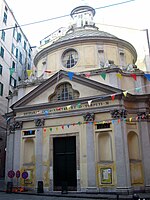Basilica di Nostra Signora Assunta, Genoa

Basilica of Our Lady of the Assumption (Italian: Basilica di Nostra Signora Assunta is a Roman Catholic church in the town of Genoa, in the Province of Genoa and the region of Liguria, Italy. This church was constructed during 1610–1624. The Baroque-style facade was added in 1932, design of the architect Piero de Barbieri; the sculptor Luigi Venzano contributed the facade statues of St. John the Baptist and St. Joseph, while the central relief depicts the Madonna. The interior was decorated across the centuries and includes works by Giulio Benso, Domenico Piola, Nicolò Barabino, and Gian Stefano Rossi. It should not be confused with the distinct Santa Maria Assunta also called Santa Maria di Carignano.
Excerpt from the Wikipedia article Basilica di Nostra Signora Assunta, Genoa (License: CC BY-SA 3.0, Authors, Images).Basilica di Nostra Signora Assunta, Genoa
Vico di San Giorgio, Genoa Centro Est
Geographical coordinates (GPS) Address Website Nearby Places Show on map
Geographical coordinates (GPS)
| Latitude | Longitude |
|---|---|
| N 44.407161111111 ° | E 8.9293444444444 ° |
Address
Chiesa di San Giorgio
Vico di San Giorgio
16123 Genoa, Centro Est
Liguria, Italy
Open on Google Maps











